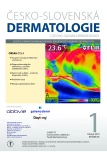Kerion Celsi in a Child: Diagnostics and Treatment Possibilities
Authors:
D. Pereira Forjaz; P. Arenberger; M. Arenbergerová; S. Gkalpakiotis
Authors‘ workplace:
Dermatovenerologická klinika 3. LF UK a FNKV, přednosta prof. MUDr. Petr Arenberger, DrSc., MBA, FCMA
Published in:
Čes-slov Derm, 94, 2019, No. 1, p. 24-28
Category:
Case Reports
Overview
Kerion Celsi is an inflammatory form of tinea capitis, which occurs mostly in prepubertal children. The authors describe a case of this disease in a 12-year-old boy, who was experiencing lesions on his scalp for 3 months. Mycological culture was positive for Trichophyton interdigitale. The source of infection was equestrian horse. Systemic treatment with oral terbinafine in dose of 250 mg daily for 12 weeks resulted in healing of all manifestations. The authors provide a comprehensive overview of current knowledge about this disease.
Keywords:
tinea capitis – Trichophyton interdigitale – Kerion Celsi – oral antifungals
Sources
1. ANDREWS, M. D., BURNS, M. B. Common tinea infections in children. Am. Fam. Physician, 2008, 77, p. 1415–1420.
2. ANG C. C., TAY, Y. K. Inflammatory tinea capitis: non-healing plaque on the occiput of a 4-year-old child. Ann. Acad. Med. Singapore, 2010, 39, 5, p.
412–414.
3. ARENAS, R., TOUSSAINT, S., ISA-ISA, R. Kerion and dermatophytic granuloma. Mycological and histopathological findings in 19 children with inflammatory tinea capitis of the scalp. Int. J. Dermatol., 2006, 45, 3, p. 215–219.
4. BORMAN, A. M., CAMPBELL, C. K., FRASER, M., JOHNSON, E. M. Analysis of the dermatophyte
species isolated in the British Isles between 1980 and 2005 and review of worldwide dermatophyte trends over the last three decades. Med. Mycol., 2007, 45, p. 131–141.
5. FRIEDLANDER, S. F., ALY, R., KRAFCHIK, B. et al. Terbinafine in the treatment of Trichophyton tinea capitis: a randomized, double-blind, parallel-group, duration-finding study. Pediatrics, 2002, 109, p.
602–607.
6. FULLER, L. C., BARTON, R. C., MOHD MUSTAPA, M. F. et al. British Association of Dermatologists’ guidelines for the management of tinea capitis 2014. British J. Dermatol., 2014, 171, p. 454–463.
7. GOLDSTEIN, A. O., GOLDSTEIN B. G. Dermatophyte (tinea) infections. In: UpToDate, Basow, DS (Ed) UpToDate, Waltham, MA, 2013.
8. GUPTA, A. K. Systemic Antifungal Agents. In: Comprehensive Dermatologic Drug Therapy, 3rd edn., London:Elsevier, 2013, p. 98–120.
9. GUPTA, A. K., DRUMMOND-MAIN, C. Meta-analysis of randomized, controlled trials comparing particular doses of griseofulvin and terbinafine for the treatment of tinea capitis. Pediatr. Dermatol., 2013, 30, p. 1–6.
10. HONIG, P.J., SULLIVAN, K., MCGOWAN, K.L. The rapid diagnosis of tinea capitis using calcofluor white. Pediatr Emerg Care, 1996, 12, p. 333–335.
11. HUBKA, V., ČMOKOVÁ, A., SKOŘEPOVÁ, M. et al. Současný vývoj v taxonomii dermatofytů a doporučení pro pojmenovávání klinicky významných druhů. Česko-slovenská dermatologie, 2014, 89, 4, p. 151–165.
12. ISA-ISA, R., ARENAS, R., ISA, M. Inflammatory tinea capitis: kerion, dermatophytic granuloma, and mycetoma. Clin. Dermatol., 2010, 4, 28, 2, p. 133–136.
13. KAKOUROU, T., UKSAL, U. European society for pediatric dermatology. Guidelines for the management of tinea capitis in children. Pediatr. Dermatol., 27, 2010, p. 226–228.
14. MAO, L., ZHANG, L., LI, H., CHEN, W. et al. Pathogenic fungus Microsporum canis activates the NLRP3 inflammasome. Infect. Immun., 2014, 82, 2, p. 882–892.
15. MITEVA, M., TOSTI, A. Hair and scalp dermatoscopy. J. Am. Acad. Dermatol., 2012, 67, p. 1040–1048.
16. SERRANO, P., FURTADO, C., ANES, I., COSTA I. O. Micoses superficiais numa consulta de Dermatologia Pediátrica - Revisão de 3 anos. Trab. Soc. Port. Dermatol. Venerol., 2005, 63, p. 341–348.
17. SKOŘEPOVÁ, M. Tinea Capitis. Čes-slov derm, 2008, 83, 6, p. 293–297.
18. STORK, J. et al. Dermatovenerologie. 2. vid. Praha: Galén-Karolinim, 2013, p. 67–73.
19. TREAT, J. R., ROSEN, T., LEVY, M. L. Tinea Capitis. In: UpToDate, 2018 (topic 99983, version 9.0).
20. VERRIER, J., KRAHENBUHL, L., BONTEMS, O. et al. Dermatophyte identification in skin and hair samples using a simple and reliable nested polymerase chain reaction assay. Br. J. Dermatol., 2013, 168, p. 295–301.
Labels
Dermatology & STDs Paediatric dermatology & STDsArticle was published in
Czech-Slovak Dermatology

2019 Issue 1
Most read in this issue
- Invasive Therapy for Chronic Venous Insuficiency
- Perianal Erosion. Minireview.
- Kerion Celsi in a Child: Diagnostics and Treatment Possibilities
- Diagnostics of Malignant Melanoma Using Total Body Photography
